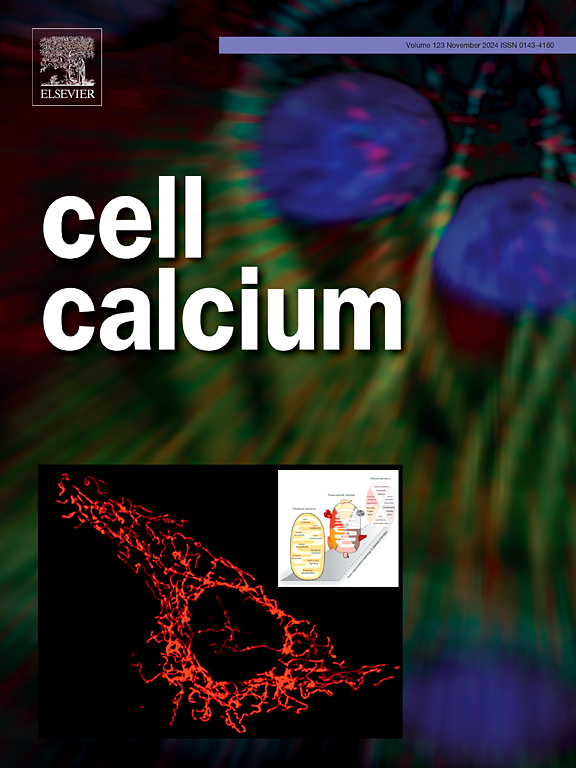Regulation of SR and mitochondrial Ca2+ signaling by L-type Ca2+ channels and Na/Ca exchanger in hiPSC–CMs
IF 4.3
2区 生物学
Q2 CELL BIOLOGY
引用次数: 0
Abstract
Rationale & methods
While signaling of cardiac SR by surface membrane proteins (ICa & INCX) is well studied, the regulation of mitochondrial Ca2+ by plasmalemmal proteins remains less explored. Here we have examined the signaling of mitochondria and SR by surface-membrane calcium-transporting proteins, using genetically engineered targeted fluorescent probes, mito-GCamP6 and R-CEPIA1er.
Results
In voltage-clamped and TIRF-imaged cardiomyocytes, low Na+ induced SR Ca2+ release was suppressed by short pre-exposures to ∼100 nM FCCP, suggesting mitochondrial Ca2+ contribution to low Na+ triggered SR Ca2+release. Even though low Na+- or caffeine-triggered SR Ca2+ release activated global mitochondrial Ca2+ uptake, focal mitochondrial Ca2+ signals varied in kinetics and magnitude, showing uptake or release of calcium, depending on cellular location of mitochondria. In spontaneously pacing cells, sustained caffeine exposures depleted the SR Ca2+ content activating mitochondrial Ca2+ uptake followed by sustained mitochondrial pacing. Spontaneous hiPSC![]() CMs pacing was strongly suppressed by L-type calcium channels blockers, but not by inhibiting SERCA2a by CPA.
CMs pacing was strongly suppressed by L-type calcium channels blockers, but not by inhibiting SERCA2a by CPA.
Conclusion
Spontaneous hiPSC![]() CMs pacing is triggered by influx of calcium through L-type Ca2+ channel that gates the release of SR pools supplemented by NCX-mediated mitochondrial calcium contribution.
CMs pacing is triggered by influx of calcium through L-type Ca2+ channel that gates the release of SR pools supplemented by NCX-mediated mitochondrial calcium contribution.

l型Ca2+通道和Na/Ca交换器对hiPSC-CMs中SR和线粒体Ca2+信号的调控
原理和方法:虽然表面膜蛋白(ICa和INCX)对心脏SR的信号传导已经得到了很好的研究,但质乳蛋白对线粒体Ca2+的调节仍然很少被探索。在这里,我们使用基因工程靶向荧光探针,mito-GCamP6和R-CEPIA1er,研究了表面膜钙转运蛋白对线粒体和SR的信号传导。结果:在电压箝位和tirf成像的心肌细胞中,低Na+诱导的SR Ca2+释放被短时间暴露于~ 100 nM FCCP抑制,这表明线粒体Ca2+对低Na+触发的SR Ca2+释放有贡献。即使低Na+或咖啡因触发的SR Ca2+释放激活了线粒体Ca2+的整体摄取,局点线粒体Ca2+信号在动力学和大小上变化,显示钙的摄取或释放,取决于线粒体的细胞位置。在自发起搏细胞中,持续的咖啡因暴露耗尽了SR Ca2+含量,激活了线粒体Ca2+摄取,随后是持续的线粒体起搏。l型钙通道阻滞剂能强烈抑制hipsccm自发性起搏,但CPA不能抑制SERCA2a。结论:自发的hiPSCCMs起搏是由钙通过l型Ca2+通道流入触发的,该通道抑制了SR池的释放,并补充了ncx介导的线粒体钙贡献。
本文章由计算机程序翻译,如有差异,请以英文原文为准。
求助全文
约1分钟内获得全文
求助全文
来源期刊

Cell calcium
生物-细胞生物学
CiteScore
8.70
自引率
5.00%
发文量
115
审稿时长
35 days
期刊介绍:
Cell Calcium covers the field of calcium metabolism and signalling in living systems, from aspects including inorganic chemistry, physiology, molecular biology and pathology. Topic themes include:
Roles of calcium in regulating cellular events such as apoptosis, necrosis and organelle remodelling
Influence of calcium regulation in affecting health and disease outcomes
 求助内容:
求助内容: 应助结果提醒方式:
应助结果提醒方式:


